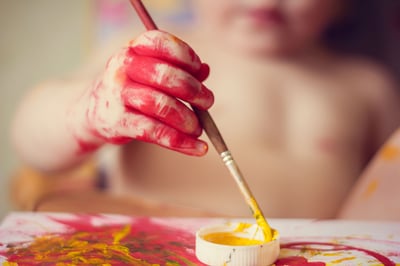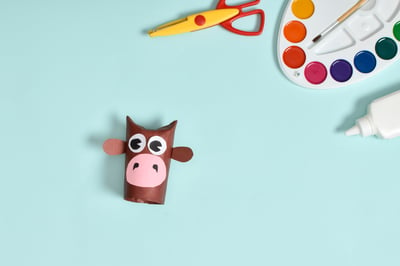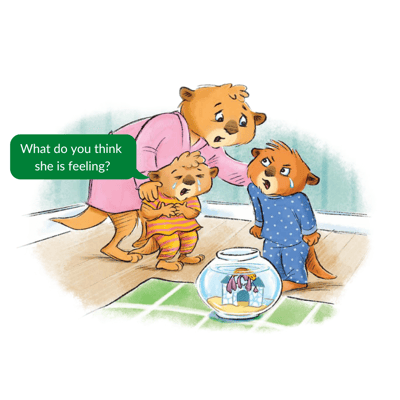
In this article, you will find 3 lesson activities you can use immediately to start child-led, process-based learning with your children.
The mind of a child is an incredible thing. They view the world around them through a unique, imaginative lens, full of wonder and excitement. Children are constantly taking in and processing new information by observing, repeating, exploring, asking questions, and trying new ideas – hundreds of thousands of synapses are formed and pruned back in their brains1 as they learn and grow. This incredible process can be nurtured and celebrated through activities that are intentionally child-led, process-based, and incorporate opportunities for emotional intelligence learning.
So often we as adults focus on the “end goal” – accomplishing something, thinking only about what will be there when we have finished. However, the process of creating something, learning something new, and experiencing different emotions throughout this process is just as (if not more) important than reaching the finish line. We tend to overlook the learning, growing, and creativity that happens along the way, but all of that “stuff in between” is what matters most.
When presented with process-based activities where they can take the lead, children learn resilience and perseverance in the face of challenging moments and flexibility from not having a set plan. They get to try new strategies, materials, movements, or ways of thinking to get new and exciting results. When working together with a friend, a group, or a team, they are given agency over sharing ideas, compromising, and talking through things they wouldn’t have otherwise known or tried on their own.
As educators and caregivers of young children, we can nurture and encourage their creative process by asking open-ended questions to give meaning to the little things that may get overlooked:
Not only do these questions engage children’s critical thinking, but they allow both children and adults to be present in the moment.
Children develop confidence and a stronger sense of self when they aren’t worrying about if their artwork fits perfectly in the lines, if their idea is as good as their friend’s, or if their creation looks the same as everyone else’s. Why ignore the process and focus on the end, when we can embrace it and make it the focal point of learning? When we do this, we are teaching children that something doesn’t need to be perfect or the same as anyone else’s to be worthwhile or worth doing – it just needs to be yours. So, let’s embrace the process together and have some fun along the way!
Here are a few of our favorite process-based ideas and activities inspired by our ECSEL Curriculum Library (ECL) that you can do at home with your children or at school with your students. Feel free to make each your own, and remember: no matter how messy, frustrating, unsuccessful, or chaotic the process may be, it is still important, and there is always more learning going on than you may think!
 Listening to music can bring forth many different emotions, and we can help children express those emotions through art activities like drawing and painting 🖌️. Select a variety of songs that have different melodies, rhythms, tempos, and instruments. Set out paper and any art supplies you have available and allow children to take the lead with which colors and materials they use.
Listening to music can bring forth many different emotions, and we can help children express those emotions through art activities like drawing and painting 🖌️. Select a variety of songs that have different melodies, rhythms, tempos, and instruments. Set out paper and any art supplies you have available and allow children to take the lead with which colors and materials they use.
Focus on their emotional intelligence by playing each song 🎵 and guiding children to draw or paint what the music makes them feel. Observe their color choices, movements (do they go along with the tempo of the music?), and what appears on their paper. Ask them about these details to engage their critical thinking and embrace the artistic process!
To explore the full version of this activity, please visit the ECSEL Curriculum Library.
 Activities that focus on constructing, building, and problem-solving tap into a variety of developmental and emotional intelligence areas: fine and gross motor skills, negotiation and compromise, noticing similarities and differences in shapes, sizes, and colors, and so much more. Embrace the process by setting out colorful recycled materials 📦, glue, and child-safe scissors ✂️ and seeing what kinds of creative ideas children come up with!
Activities that focus on constructing, building, and problem-solving tap into a variety of developmental and emotional intelligence areas: fine and gross motor skills, negotiation and compromise, noticing similarities and differences in shapes, sizes, and colors, and so much more. Embrace the process by setting out colorful recycled materials 📦, glue, and child-safe scissors ✂️ and seeing what kinds of creative ideas children come up with!
Narrow the focus with a theme or topic that interests children (their favorite color 🖍️, dinosaurs, machines 🤖, etc.) and support them in taking the lead by asking them questions like:
You can even turn this into a collaborative teamwork activity to focus on building empathy: How can we make sure everyone feels heard and included?
To explore the full version of this activity, please visit the ECSEL Curriculum Library.
 Young children are natural storytellers, especially when given the opportunity to share their feelings and tell you about the things they are most interested in. Tap into this creativity and embrace the process! Start by selecting a favorite storybook 📖 in which characters experience different emotions, run into problems or conflicts, and find solutions. As you read the story, ask children to help you fill in the emotional “blanks” by looking at the characters’ facial expressions.
Young children are natural storytellers, especially when given the opportunity to share their feelings and tell you about the things they are most interested in. Tap into this creativity and embrace the process! Start by selecting a favorite storybook 📖 in which characters experience different emotions, run into problems or conflicts, and find solutions. As you read the story, ask children to help you fill in the emotional “blanks” by looking at the characters’ facial expressions.
This seemingly simple activity can turn reading and storytelling into an active learning process, all while building children’s emotional competency skills, social skills like empathy and perspective-taking, and problem-solving skills.
To explore the full version of this activity, please visit the ECSEL Curriculum Library.
These Posts on ECSEL
Housman Institute, LLC
831 Beacon Street, Suite 407
Newton, MA 02459
info@housmaninstitute.org
(508)379-3012
Explore
Our Products
Legal
Connect
Contact
Join our Mailing List!
Subscribe to receive our newsletter, latest blogs, and ECSEL resources.
We respect and value your privacy.
No Comments Yet
Let us know what you think